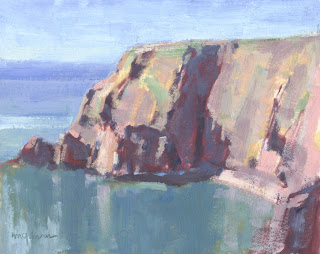"Blue Tug" 12x12, oil
This past weekend marked the fifth annual paintout of the Plein Air Painters of the Bay of Fundy. Every year, we alternate between the US and Canada for the event, and in keeping with that theme, the 2011 event was in Eastport, Maine. (See www.PleinAirFundy.org for previous years and locations.)
Ten of our group, which consists of over 30 committed outdoor painters mostly from Downeast Maine, New Brunswick and Nova Scotia, had planned to meet Saturday. Unfortunately, a world-class thunderstorm spent the day hurling lightning bolts and dumping torrential rains over the area. I've seen some pretty strong storms during monsoon season in the mountains of New Mexico, and this one tied for first place. Needless to say, the meeting didn't happen, and although a couple braved the storm from porches, most of us held back that day. Sunday wasn't promised to be any better, so we opened up the painting period through Tuesday, and moved the "hanging" to Wednesday.
But Sunday turned out better than predicted, and several of us went to Eastport on our own schedules. I ended up down by the wharf and painted in some heavy overcast. Trina spotted an unusual blue tugboat for me, and I painted it. There are a couple of tugs in Eastport, but I've never seen a blue one. The color was just perfect for the weather conditions. The painting is at the top of this post. In the photo below, you can see that the tug rotated 180 degrees while I painted it. Any boat that isn't tied up to a wharf requires quick drawing skills!
I ran across Evelyn Dunphy (below), who was painting at the opposite end of the Eastport wharf. She was working on a large, multi-session watercolor. After returning home, I later learned that Simone Ritter and Caren-Marie Michel had also been in the area. If would have been nice to have had coffee with everyone, but Eastport is a cell phone dead zone, and there is no way to communicate other than by flare gun. But that's why we love this area - the remoteness keeps things quiet. (Except for the occasional flare gun.)
If you're in the area, please plan on coming to our opening reception at Next Door Gallery, 8 Boynton Street, Eastport, Maine, from 4-6 Eastern Time on Friday, July 1st. (Add it to your Canada Day / Independence Day celebrations!) The show will be up from June 29 through July 14th. For details, visit www.PleinAirFundy.org.















































